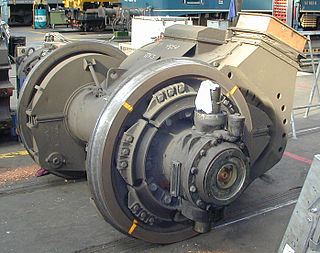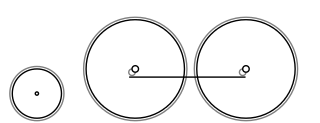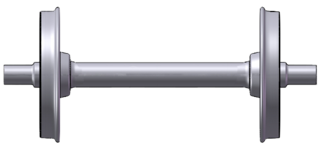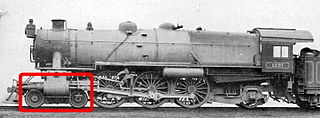
A bogie is a chassis or framework that carries a wheelset, attached to a vehicle—a modular subassembly of wheels and axles. Bogies take various forms in various modes of transport. A bogie may remain normally attached or be quickly detachable ; it may contain a suspension within it, or be solid and in turn be suspended ; it may be mounted on a swivel, as traditionally on a railway carriage or locomotive, additionally jointed and sprung, or held in place by other means.

Whyte notation is a classification method for steam locomotives, and some internal combustion locomotives and electric locomotives, by wheel arrangement. It was devised by Frederick Methvan Whyte, and came into use in the early twentieth century following a December 1900 editorial in American Engineer and Railroad Journal.

Under the Whyte notation for the classification of steam locomotives, 0-4-0 represents one of the simplest possible types, that with two axles and four coupled wheels, all of which are driven. The wheels on the earliest four-coupled locomotives were connected by a single gear wheel, but from 1825 the wheels were usually connected with coupling rods to form a single driven set.
In rail transport, a wheel arrangement or wheel configuration is a system of classifying the way in which wheels are distributed under a locomotive. Several notations exist to describe the wheel assemblies of a locomotive by type, position, and connections, with the adopted notations varying by country. Within a given country, different notations may also be employed for different kinds of locomotives, such as steam, electric, and diesel powered.

On a steam locomotive, a driving wheel is a powered wheel which is driven by the locomotive's pistons. On a conventional, non-articulated locomotive, the driving wheels are all coupled together with side rods ; normally one pair is directly driven by the main rod which is connected to the end of the piston rod; power is transmitted to the others through the side rods.
Rail terminology is a form of technical terminology. The difference between the American term railroad and the international term railway is the most significant difference in rail terminology. There are also others, due to the parallel development of rail transport systems in different parts of the world.

A rotameter is a device that measures the volumetric flow rate of fluid in a closed tube.

4-4-0 is a locomotive type with a classification that uses the Whyte notation for the classification of steam locomotives by wheel arrangement and represents the arrangement: four leading wheels on two axles, four powered and coupled driving wheels on two axles, and a lack of trailing wheels. Due to the large number of the type that were produced and used in the United States, the 4-4-0 is most commonly known as the American type, but the type subsequently also became popular in the United Kingdom, where large numbers were produced.

Under the Whyte notation for the classification of steam locomotives by wheel arrangement, 4-6-0 represents the configuration of four leading wheels on two axles in a leading bogie and six powered and coupled driving wheels on three axles with the absence of trailing wheels. In the mid 19th century, this wheel arrangement became the second most popular configuration for new steam locomotives in the United States, where this type is commonly referred to as a ten-wheeler. As a locomotive pulling trains of lightweight all-wood passenger cars in the 1890–1920s, it was exceptionally stable at near 100 mph (160 km/h) speeds on the New York Central's New York to Chicago Water Level Route and on the Reading Railroad's Camden to Atlantic City, NJ, line. As passenger equipment grew heavier with all steel construction, heavier locomotives replaced the ten-wheeler.

In railroading, a derailment occurs when a rail vehicle such as a train comes off its rails. Although many derailments are minor, all result in temporary disruption of the proper operation of the railway system and they are a potentially serious hazard.

Yokogawa Electric Corporation is a Japanese multinational electrical engineering and software company, with businesses based on its measurement, control, and information technologies.

Under the Whyte notation for the classification of steam locomotives, a 2-6-4 locomotive has two leading wheels, six coupled driving wheels and four trailing wheels. This arrangement is commonly called Adriatic.

Under the Whyte notation for the classification of steam locomotives, 2-4-0 represents the wheel arrangement of two leading wheels on one axle, four powered and coupled driving wheels on two axles and no trailing wheels.

An adhesion railway relies on adhesion traction to move the train. Adhesion traction is the friction between the drive wheels and the steel rail. The term "adhesion railway" is used only when it is necessary to distinguish adhesion railways from railways moved by other means, such as by a stationary engine pulling on a cable attached to the cars or by railways that are moved by a pinion meshing with a rack.
Rail Wheel Factory, Yelehanka (RWF) is a manufacturing unit of Indian Railways, producing wheels, axles and wheel sets of railroad wagons, coaches and locomotives for the use of Indian Railways and overseas customers is situated at Yelahanka, Bangalore in the Indian state of Karnataka.
A class of locomotives is a group of locomotives built to a common design, typically for a single railroad or railway. Often members of a particular class had detail variations between individual examples, and these could lead to subclasses. Sometimes technical alterations move a locomotive from one class to another. Different railways had different systems, and sometimes one railway used different systems at different times and for different purposes, or applied those classifications inconsistently. Sometimes therefore it is not clear where one class begins and another ends. The result is a classic example of the Lumper splitter problem.

A wheelset is a pair of railroad vehicle wheels mounted rigidly on an axle such that both wheels rotate in unison. Wheelsets are often mounted in a bogie – a pivoted frame assembly holding at least two wheelsets – at each end of the vehicle. Most modern freight cars and passenger cars have bogies each with two wheelsets, but three wheelsets are used in bogies of freight cars that carry heavy loads, and three-wheelset bogies are under some passenger cars. Four-wheeled goods wagons that were once near-universal in Europe and Great Britain and their colonies have only two wheelsets; in recent decades such vehicles have become less common as trainloads have become heavier.
Brooks Instrument is a manufacturer of flow control and measurement equipment based in Hatfield, PA. It was a division of Emerson (NYSE:EMR) until December 31, 2007 when it was sold to American Industrial Partners Capital Fund IV (“AIP”) for approximately $100 million in cash. In January 2012, Brooks Instrument was acquired by ITW for an unspecified amount.

The leading wheel or leading axle or pilot wheel of a steam locomotive is an unpowered wheel or axle located in front of the driving wheels. The axle or axles of the leading wheels are normally located on a leading truck. Leading wheels are used to help the locomotive negotiate curves and to support the front portion of the boiler.

Rail Wheel Plant, Bela is an independent Production Unit of Indian Railways. It is situated in Bela Gram Panchayat, Dariapur Block, Parsa in Saran district of Bihar. It was inaugurated in 2008 by the former Railway Minister of India, Laloo Prasad Yadav. It was built at a cost of ₹1,450 crore (US$190 million). It is spread over a land area of 165 acres.















